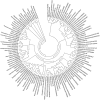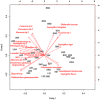Diversity of endophytic mycobiota of tropical tree Tectona grandis Linn.f.: Spatiotemporal and tissue type effects
- PMID: 28623306
- PMCID: PMC5473821
- DOI: 10.1038/s41598-017-03933-0
Diversity of endophytic mycobiota of tropical tree Tectona grandis Linn.f.: Spatiotemporal and tissue type effects
Abstract
Fungal endophytes were isolated from leaf, bark and stem of Tectona grandis Linn.f. sampled at four geographical locations in winter, summer and monsoon seasons. The recovered 5089 isolates were assigned to 45 distinct morphotypes based on morphology. The sequences of the internal transcribed spacers (ITS) of the nrDNA of some morphotypes were identical, but morphological differences were strong enough to consider these morphotypes as separate species. Forty-three morphotypes were assigned to ascomycotina and two to basidiomycotina. Ascomycotina was the predominating group with 99.7% of total isolates followed by basidiomycotina with only 0.3% of total isolates. Diaporthe (Phomopsis) species dominated the communities independently on tissue type, location or season. More than 60% of the examined tissue pieces were colonized by members of this species complex. While these endophytes are ubiquitous others were tissue or location specific. Tissue type had the strongest effect on the species evenness of the endophytic assemblage followed by geographical location and season. However, Shannon-Wiener index (H') significantly (p ≤ 0.001) varied with all three factors i.e. season, location and tissue type. Leaves supported the highest diversity across all the seasons and locations. In conclusion, all the three factors together determined the structure of endophytic mycobiota assemblage of T. grandis.
Conflict of interest statement
The authors declare that they have no competing interests.
Figures



Similar articles
-
Season and tissue type affect fungal endophyte communities of the Indian medicinal plant Tinospora cordifolia more strongly than geographic location.Microb Ecol. 2012 Aug;64(2):388-98. doi: 10.1007/s00248-012-0029-7. Epub 2012 Mar 20. Microb Ecol. 2012. PMID: 22430503
-
Diversity and Spatiotemporal Distribution of Fungal Endophytes Associated with Citrus reticulata cv. Siyahoo.Curr Microbiol. 2019 Mar;76(3):279-289. doi: 10.1007/s00284-019-01632-9. Epub 2019 Jan 28. Curr Microbiol. 2019. PMID: 30689005
-
Endophytic Phomopsis species: host range and implications for diversity estimates.Can J Microbiol. 2006 Jul;52(7):673-80. doi: 10.1139/w06-020. Can J Microbiol. 2006. PMID: 16917524
-
Spatial and seasonal influences on culturable endophytic mycobiota associated with different tissues of Eugenia jambolana Lam. and their antibacterial activity against MDR strains.BMC Microbiol. 2016 Mar 18;16:44. doi: 10.1186/s12866-016-0664-0. BMC Microbiol. 2016. PMID: 26988842 Free PMC article.
-
Culturable endophytic fungi community structure isolated from Codonopsis pilosula roots and effect of season and geographic location on their structures.BMC Microbiol. 2023 May 15;23(1):132. doi: 10.1186/s12866-023-02848-3. BMC Microbiol. 2023. PMID: 37189022 Free PMC article.
Cited by
-
Bioprospecting of endophytes in medicinal plants of Thar Desert: An attractive resource for biopharmaceuticals.Biotechnol Rep (Amst). 2021 May 24;30:e00629. doi: 10.1016/j.btre.2021.e00629. eCollection 2021 Jun. Biotechnol Rep (Amst). 2021. PMID: 34136363 Free PMC article. Review.
-
A multiscale study of fungal endophyte communities of the foliar endosphere of native rubber trees in Eastern Amazon.Sci Rep. 2018 Nov 1;8(1):16151. doi: 10.1038/s41598-018-34619-w. Sci Rep. 2018. PMID: 30385829 Free PMC article.
-
Diversity and bioactivities of fungal endophytes from Distylium chinense, a rare waterlogging tolerant plant endemic to the Three Gorges Reservoir.BMC Microbiol. 2019 Dec 10;19(1):278. doi: 10.1186/s12866-019-1634-0. BMC Microbiol. 2019. PMID: 31822262 Free PMC article.
-
Endophytic Fungi from Terminalia Species: A Comprehensive Review.J Fungi (Basel). 2019 May 24;5(2):43. doi: 10.3390/jof5020043. J Fungi (Basel). 2019. PMID: 31137730 Free PMC article. Review.
-
Host species shape the community structure of culturable endophytes in fruits of wild berry species (Vaccinium myrtillus L., Empetrum nigrum L. and Vaccinium vitis-idaea L.).FEMS Microbiol Ecol. 2021 Jul 20;97(8):fiab097. doi: 10.1093/femsec/fiab097. FEMS Microbiol Ecol. 2021. PMID: 34251452 Free PMC article.
References
-
- de Bary. Morphologie und Physiologie der Pilze, Flechten und Myxomyceten. Hofmeister’s Hand Book of Physiological Botany. Vol. 2 (Leipzig, 1866).
-
- Bacon, C. W. & White, J. F. Microbial endophytes (eds Bacon, C. W. & White, J. F.) 487 (Marcel-Dekker, New York, USA, 2000).
-
- Arnold AE, Maynard Z, Gilbert GS, Coley PD, Kursar TA. Are tropical fungal endophytes hyperdiverse? Ecol. Lett. 2000;3:267–274. doi: 10.1046/j.1461-0248.2000.00159.x. - DOI
-
- Persoh D. Factors shaping community structure of endophytic fungi-evidence from the Pinus-Viscum-system. Fungal Divers. 2013;60:55–69. doi: 10.1007/s13225-013-0225-x. - DOI
Publication types
MeSH terms
LinkOut - more resources
Full Text Sources
Other Literature Sources

